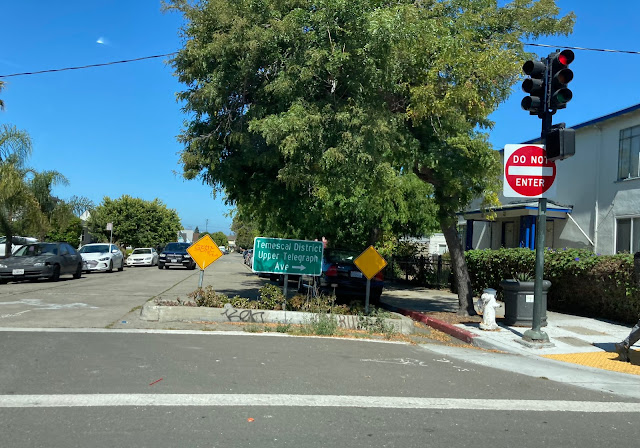A residential building on West Street in Manhattan has a unique feature at street level. The street trees are planted in a grove. Technically, the trees are not in the public right-of-way. They are growing in the building's setback. However, their layout and relationship to nearby street trees are striking. This sighting was the nudge I needed to write about street tree planting design. I will cover three aspects of street tree planting design: the arrangement of street trees in the public right-of-way, species selection, and forest structure. I will conclude with several creative solutions.
Street Tree Layout
The tree-lined city has its origins in the late 16th century and early 17th century when trees were planted along canals in Amsterdam (Lawrence, 1988). Street trees are usually planted in a single row on the curbside of the sidewalk. The design goal is to create even spacing, respecting the average canopy spread of the tree at maturity, and creating a harmonious look. Traditionally, both sides of the block were planted with trees of the same age and species, also known as an allee.
Another planting design, though not common, is to plant parallel rows of trees on a single side of a block to create a block-level allee. Sometimes there are accidental allees, an affect that is created between street trees and trees planted on adjacent land.
A prevailing street tree convention was to plant monocultures of a single species with trees of the same ranging from the block level to entire streets. The planting of streets with a single species has fallen out of favor. As cities have dealt with devastating canopy losses due to pests and diseases, urban foresters, designers, and planners are aware of the negative consequences of tree monocultures in cities. Recognition of the problem, however, does not always lead to implementation of mixed species canopy. It is insufficient to only consider species diversity. Genus and genetic diversity are important factors in urban forest health.
Did you know that New York State's urban frest canopy is dominated by only four genus (Bassuk, 2018)? The genera are: Acer (44.27%), Quercus (7.02%), Gleditsia (4.94%), and Tilia (4.07%).
Age diversity is another population factor worthy of attention. One downside to widely planting same-aged trees is the potential for simultaneous decline and death.
Street trees are typically planted as individual tree beds along a street. Many municipalities encourage residents to plant in tree pits. NYC provides a plant list that includes native annuals and perennials, but recommends planting "flowers that have shallow roots and die back each year (annuals)." Perennials are more sustainable, and native and naturalized perennials provide multiple ecosystem services. Can you imagine designing sylvan streetscapes by adding shrubs between the street tree canopy and the herbaceous layer?
Non-traditional street tree planting design
The pace of change in street tree planting design is slow. Technological advances in soil haven't changed the pattern of planting on sidewalks. Structural soil was designed to enable optimal root growth and compaction that meets engineering standards for load bearing. Even with the ability to support tree growth and meet compaction standards, trees are still relegated to the curb. The reasons we aren't seeing more innovation in streetscapes include traditional aesthetics, narrow sidewalks, maintenance, and engineering standards, and risk and liability management. New York City has 19th century infrastructure in the 21st century and nowhere is that more the case than in street tree planting techniques and design.
Here are several creative street tree planting in the public right-of-way.
Stormwater Greenstreets are located in flooding hotspots and in
neighborhoods with waterways classified as having poor water quality.
These greenstreets are designed to mitigate 1.7 inches of rain using the following features: inlets
and outlets (curb cuts), bioswales, and engineered
soil profiles. Each greenstreet system captures, stores, and infiltrate stormwater. (More)
Jane Martin responded to the San Francisco Neighborhood Parks Council's 2003 call for proposals to add greenspace to the Mission District neighborhood of San Francisco in 2003. She began designing "parks along the way" or "parks right out your door" and made them permeable to also respond to annual, intense flooding of streets, sidewalks, and buildings in San Francisco. (More)
"Parking Trees," Washington DC
The land between the building line and the sidewalk, known as the "parking zone," is owned by the municipality though maintenance is the responsibility of the adjacent property owner. On Massachusetts Avenue in DC, trees in the sidewalk as well as trees in this "parking zone" create allees on each side of the avenue.
Sidewalk forests of native species to support other plants and animal wildlife are the brainchild of PopUp Forest founder, Marielle Anzelone.
What's Next?
Nearby nature provides many benefits to people, plants, and wildlife. One of the most local elements of nature in cities is the street tree. We can maximize the potential of the city's street trees by thinking of them as an eco-system and not as individual objects to be managed like hard infrastructure. We should plant for genus and species (and genetic) diversity, plant to provide the kind of shade that can mitigate extreme heat, and underplant to tackle extreme flooding. We can provide ecosystem service benefits as Jane Martin says, "right out your door." Check out StreetsBlog Mass's article What Planting in the Street Could Look Like in Boston. Keep in mind: there is no one size fits all. This last point is critical. Cities should be mindful of barriers and resistance to participating in neighborhood greening which stem from legacies of urban renewal and displacement, a lack of agency in program design and implementation, and ecosystem disservices including maintenance costs.










Comments
Post a Comment
Thank you for commenting on this post!